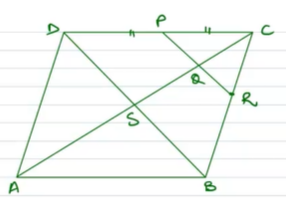In ABC, a point P is taken on AB such that AP/BP=1/3 and point Q is taken on BC such that CQ/BQ=3/1 . If R is the point of intersection of the lines AQandCP, ising vedctor method, find the are of ABC if the area of BRC is 1 unit
The correct Answer is:139 sq. unit
Taking A as origin let →band→c be the postion vectors of B and C , respectively,
The position vector of Q is 3→b+→c4 and that of p is →b4
ifARQR=λ1 then position vector of R = λ(3→b+→c4) ltbRgt if CRRP=μ1 then position vector of R = μ→b4+→cμ+1 (ii)
comparing (i) and (ii) , we have,
3λ4=μ4(μ+1)andλ4=1μ+1
solving , λ=413andμ=12
Therefore, position , vector R is 3→b+→c13
△ABCand△BRC have the same base. there area are proporotional to AQ and RQ
△ABC△BRC=∣∣∣3→b+→c4∣∣∣∣∣∣3→b+→c4−(3→b+→c13)∣∣∣=139
Area of △ABC is 13/9 units.

Topper's Solved these Questions
- DIFFERENT PRODUCTS OF VECTORS AND THEIR GEOMETRICAL APPLICATIONS Book:CENGAGEChapter:DIFFERENT PRODUCTS OF VECTORS AND THEIR GEOMETRICAL APPLICATIONS Exercise:Exercise
Explore 337 Videos
- DETERMINANTSBook:CENGAGEChapter:DETERMINANTSExercise:Question Bank
Explore 23 Videos
- DIFFERENTIAL EQUATIONSBook:CENGAGEChapter:DIFFERENTIAL EQUATIONSExercise:Question Bank
Explore 25 Videos
Similar Questions
In ABC , P divides the side AB such that AP:PB=1:2 . Q is a point in AC such that PQBC . Find the ratio of the areas of APQ and trapezium BPQC .
View SolutionABCD is a parallelogram. P is a point on AD such that AP=13 AD and Q is a point on BC such that: CQ=13BC. Prove that AQCP is a parallelogram.
View SolutionP is any point on base BC of ABC and D is the mid-point of BC.DE is drawn parallel to PA to meet AC at E. If ar(ABC)=12cm2 , then find area of EQC
View SolutionABCD is a parallelogram. P is the mid-point of AB.BD and CP intersect at Q such that CQ:QP=3:1. If ar (PBQ)=10 cm2, find the area of parallelogram ABCD
View SolutionIn Figure, ABCD is a parallelogram in which P is the mid-point of DC and Q is a point on AC such that CQ=14AC. If PQ produced meets BC at R, prove that R is a mid-point of BC
View Solutionp AND q are any two points lying on the sides DC and AD respectively of a parallelogram ABCD. Show that ar(APB)=ar (BQC).
View SolutionIn square ABCD, P and Q are mid-point of AB and CD respectively. If AB=8cm and PQ and BD intersect at O, then find area of OPB
View SolutionIn Figure, ABCD is a parallelogram in which P is the mid-point of DC and Q is a point on AC such that CQ=14AC. If PQ produced meets BC at R. Prove that R is a mid-point of BC.

View SolutionABC is a triangle, P is a point on ABandQ is a point on AC such that ∠AQP=∠ABC. Complete the relation AreaofAPQAreaofABC=.()AC2 .
View SolutionPQRS is a trapezium having PS a n d QR as parallel sides. A is any point on PQandB is a point on SR such that ABQR . If area of PBQ is 17cm2, find the area of ASR
View Solution

